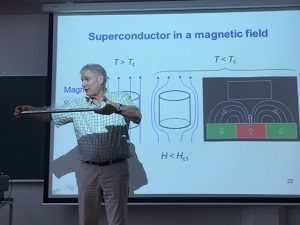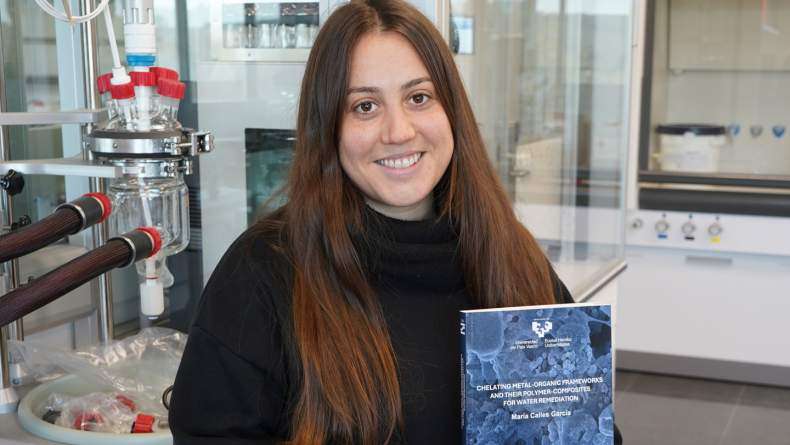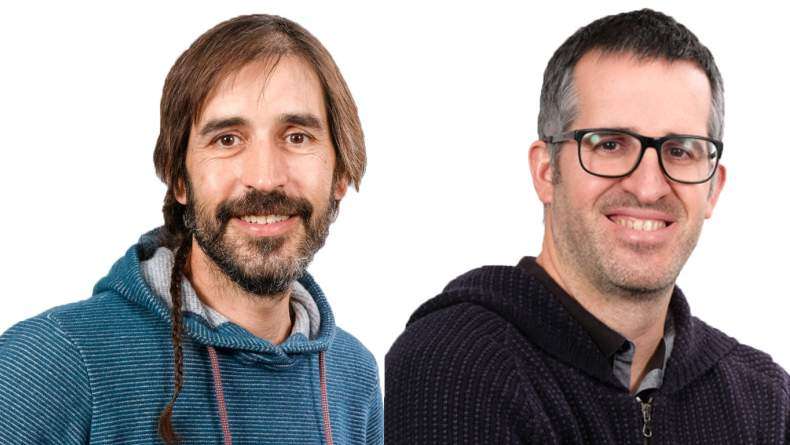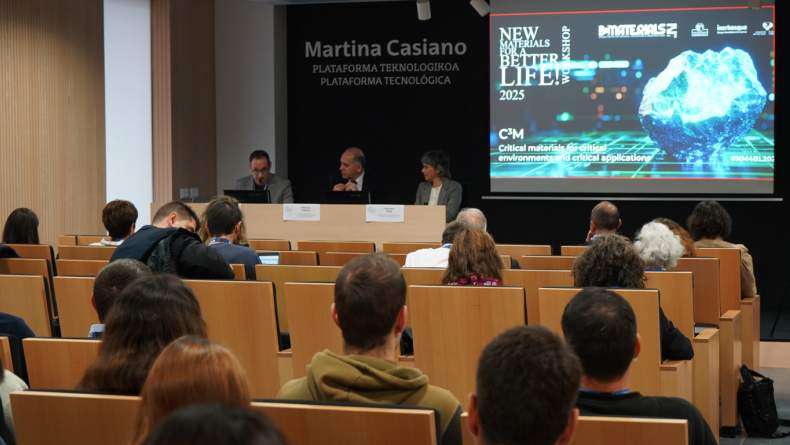Professor Ludwig Schultz Seminar

Last thursday, on the tenth day of september, Professor Ludwig Schultz gave a talk about superconducting levitation at the Science and Technology Faculty of the University of the Basque Country (UPV/EHU). During the talk, he exposed different mechanisms of levitation by means of magnetic materials for urban transportation.
The first mechanism consists on the employment of magnets to make the mean of transportation levitate. The chinese train called Shanghai Maglev levitates thanks to this principle: the inferior part of the train, the track and the laterals of the chanel through which the carriages move, are magnets, the train levitates by controlling the repulsion forces.  The other mechanism is based on the use of a superconducting disk which is within the transportation mean and a permanent magnet which is the material of the tracks. Professor Schulz underlined two important points. First, the disk has to be cooled by liquid nitrogen to acquire the superconducting behaviour. Secondly, he emphasized the importance of introducing defects in the superconducting disk to make the disk act as a permanent magnet and trap the magnetic field lines. He made an experiment to demosntrate this point by using a small track of FeNdB (permanent magnet) and a YBa Cu disk (superconducting disk): in the first trial he used a disk without defects, so when he put the track upside down the disk falled down, but when using a defect cotaining disk, it kept on moving along the track although it was upside down. Afterwards, Professor Schulz carried out another experiment using a small closed circuit and small trains containing the superconducting disks. The trains where put on, under and on the sides of the tracks and after applying an inicial external force, the levitating trains moved within the circuit until the disks were warmed and they lost their superconducting behaviour.
The other mechanism is based on the use of a superconducting disk which is within the transportation mean and a permanent magnet which is the material of the tracks. Professor Schulz underlined two important points. First, the disk has to be cooled by liquid nitrogen to acquire the superconducting behaviour. Secondly, he emphasized the importance of introducing defects in the superconducting disk to make the disk act as a permanent magnet and trap the magnetic field lines. He made an experiment to demosntrate this point by using a small track of FeNdB (permanent magnet) and a YBa Cu disk (superconducting disk): in the first trial he used a disk without defects, so when he put the track upside down the disk falled down, but when using a defect cotaining disk, it kept on moving along the track although it was upside down. Afterwards, Professor Schulz carried out another experiment using a small closed circuit and small trains containing the superconducting disks. The trains where put on, under and on the sides of the tracks and after applying an inicial external force, the levitating trains moved within the circuit until the disks were warmed and they lost their superconducting behaviour.  Finally, Professor Schulz showed some images of SupraTrans II research center in Dresden, where they have developed a trasnporation mean based on the superconducting-permanent magnet principle. According to the professor, the advantages of this novel mean of urban transportation are the absence of friction, vibration and noise, and also the fact that it avoids the emission of any contaminant gases. He proposed the superconducting levitation as a promising alternative in the urban transportation for the short run.
Finally, Professor Schulz showed some images of SupraTrans II research center in Dresden, where they have developed a trasnporation mean based on the superconducting-permanent magnet principle. According to the professor, the advantages of this novel mean of urban transportation are the absence of friction, vibration and noise, and also the fact that it avoids the emission of any contaminant gases. He proposed the superconducting levitation as a promising alternative in the urban transportation for the short run.
 The other mechanism is based on the use of a superconducting disk which is within the transportation mean and a permanent magnet which is the material of the tracks. Professor Schulz underlined two important points. First, the disk has to be cooled by liquid nitrogen to acquire the superconducting behaviour. Secondly, he emphasized the importance of introducing defects in the superconducting disk to make the disk act as a permanent magnet and trap the magnetic field lines. He made an experiment to demosntrate this point by using a small track of FeNdB (permanent magnet) and a YBa Cu disk (superconducting disk): in the first trial he used a disk without defects, so when he put the track upside down the disk falled down, but when using a defect cotaining disk, it kept on moving along the track although it was upside down. Afterwards, Professor Schulz carried out another experiment using a small closed circuit and small trains containing the superconducting disks. The trains where put on, under and on the sides of the tracks and after applying an inicial external force, the levitating trains moved within the circuit until the disks were warmed and they lost their superconducting behaviour.
The other mechanism is based on the use of a superconducting disk which is within the transportation mean and a permanent magnet which is the material of the tracks. Professor Schulz underlined two important points. First, the disk has to be cooled by liquid nitrogen to acquire the superconducting behaviour. Secondly, he emphasized the importance of introducing defects in the superconducting disk to make the disk act as a permanent magnet and trap the magnetic field lines. He made an experiment to demosntrate this point by using a small track of FeNdB (permanent magnet) and a YBa Cu disk (superconducting disk): in the first trial he used a disk without defects, so when he put the track upside down the disk falled down, but when using a defect cotaining disk, it kept on moving along the track although it was upside down. Afterwards, Professor Schulz carried out another experiment using a small closed circuit and small trains containing the superconducting disks. The trains where put on, under and on the sides of the tracks and after applying an inicial external force, the levitating trains moved within the circuit until the disks were warmed and they lost their superconducting behaviour.  Finally, Professor Schulz showed some images of SupraTrans II research center in Dresden, where they have developed a trasnporation mean based on the superconducting-permanent magnet principle. According to the professor, the advantages of this novel mean of urban transportation are the absence of friction, vibration and noise, and also the fact that it avoids the emission of any contaminant gases. He proposed the superconducting levitation as a promising alternative in the urban transportation for the short run.
Finally, Professor Schulz showed some images of SupraTrans II research center in Dresden, where they have developed a trasnporation mean based on the superconducting-permanent magnet principle. According to the professor, the advantages of this novel mean of urban transportation are the absence of friction, vibration and noise, and also the fact that it avoids the emission of any contaminant gases. He proposed the superconducting levitation as a promising alternative in the urban transportation for the short run.
Related news
María Calles, New Doctor of BCMaterials
We would like to congratulate María Calles García for obtaining her PhDs in Materials Science and Technology from the UPV/EHU. On December 4 made a brilliant defense of her thesis titled ‘Chelating…Invited Talk with Barcelona Microelectronics Institute’s researchers (December 3)
On December 3 at 12:00 PM, in the Martina Casiano Auditorium in Leioa, BCMaterials will host senior researchers Antón Guimerà and Xavier Illa from the Barcelona Microelectronics Institute (IMB-CNM,…Invited Talk by Liu Yao on Lithium-Metal Batteries (December 2)
Next Monday, December 2, Liu Yao, professor at the Shanghai Institute of Applied Physics, will give an invited lecture at BCMaterials entitled ‘Li-Metal Batteries: From Liquid to Solid-State’. The…Success of BCMaterials’ Annual Workshop on Critical Materials
The 2025 edition of BCMaterials’ annual workshop gathered nearly one hundred participants on November 19 in Leioa to review the latest advances and discuss critical materials, their applications, and…



